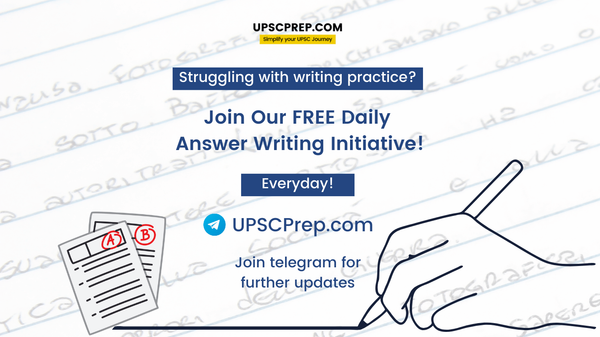Subject: GS 1
Syllabus: Modern Indian history from about the middle of the eighteenth century until the present- significant events, personalities, issues.
Questions
- What were the conditions and circumstances that led to the emergence of the Socialist Movement in India? Analyse the impact of socialist ideas on the Indian National Movement. (250 Words, 15 Marks)
- As India grapples increasingly with changing social and religious circumstances, Raja Ram Mohan Roy’s work in socio-religious reforms finds new relevance in contemporary times. Elaborate. (250 Words, 15 Marks)
Model Structure
1. What were the conditions and circumstances that led to the emergence of the Socialist Movement in India? Analyse the impact of socialist ideas on the Indian National Movement. (250 Words, 15 Marks)
Model Structure
Introduction:
- Socialism is an economic and political system based on collective or public ownership of the means of production.
- The growth of socialist thought in India took place mainly in the twentieth century, unlike in the west where it had flourished in the nineteenth century.
Main Body:
- Emergence of the Socialist Movement in India:
- Russian Revolution: Became the living example of the power of the working class.
- Effect of Marxism: Led to the formation of groups based on the socialist ideology like the Communist Party of India (CPI) etc.
- Impact of World War I: Led to inflation, rising unemployment and increased exploitation of the colonies.
- Failure of the Civil Disobedience movement: Led to the formation of the Congress Socialist Party (CSP) within the Congress.
- Great Economic Depression: The global depression in the 1930s brought the capitalist system into disrepute.
- Impact of socialist ideas on the Indian National Movement:
- Important leaders like Jawaharlal Nehru, Subash Chandra Bose, Jayaprakash Narayan, Rammanohar Lohia etc. were thinkers of the socialist stream in India.
- The Communist Party of India (CPI) which was formed in 1925 believed in the theory of class struggle and the establishment of a socialist society through revolution
- Congress Socialist Party (CSP), 1934 aimed at achieving complete independence of India from imperialism and the establishment of a socialist society.
- Sessions of Congress like-
- Karachi session 1931 (socialist pattern of development was set as the goal for India).
- Faizpur session 1936 etc. reflected Socialist ideology.
- First all-India conference of the socialists held in 1934 at Patna under the presidentship of Acharya Narendra Dev. They played an important role in the Quit India Movement.
- Inspired radical socialists like Bhagat Singh to form organisations such as Hindustan Socialist Republican Association (HSRA).
- Peasant uprisings (like Tebhaga Movement etc.) against the oppression by zamindars and the Britishers.
- Formation of trade unions (All India Trade Union Congress, 1920), Kisan Mazdoor Sabha etc.
Conclusion:
- Socialist principles helped in making the Indian freedom movement more inclusive. These ideas were retained as guiding principles in the Constitution of independent India.
2. As India grapples increasingly with changing social and religious circumstances, Raja Ram Mohan Roy’s work in socio-religious reforms finds new relevance in contemporary times. Elaborate. (250 Words, 15 Marks)
Model Structure
Introduction:
- On the 250th anniversary of Raja Ram Mohan Roy, his principles are still relevant in current times.
Main Body:
- Social evil practices in the 18th century
- Ram Mohan Roy’s works to bring socio-religious reforms:
- He brought principles of human dignity and rationality to the forefront.
- Established Brahmo Samaj 1828 evolved as a reaction against the upper-caste stranglehold on social customs and rituals.
- (During the Bengal Renaissance, birthed the Brahmo religion, a reformed spiritual Hinduism that believes in monotheism and the uniformity of all men, irrespective of caste, class or creed.)
- In 1814, he started the Atmiya Sabha (Society of Friends), to nurture philosophical discussions on the idea of monotheism in Vedanta and to campaign against idolatry, casteism, child marriage so on.
- Fought vigorously against SATI and helped bring abolition of sati in 1829 under the governor general ship of William Bentinck in 1829.
- Preached to integrate best from several religions and monotheism.
- Example: precepts of Jesus.
- He campaigned for the modernisation of education, in particular the introduction of a Western curriculum, and started several educational institutions. eg. Supported David Hare's efforts to found The Hindu College and established English school and Vedanta college.
- Relevance in contemporary India:
- Female infanticide and skewed sex ratio: though sex ratio has been improving. The cases of missing and unwanted girl children continue unabated.
- Continuing practice of untouchability: Forms such as manual scavenging. National Human Rights Commission (NHRC) on the Prevention of Atrocities against Scheduled Castes, a crime is committed against a Dalit every 18 minutes.
- Dowry: India reports the highest number of dowry deaths. According to NCRB reports, on average, every hour, a woman succumbs to dowry death in India.
- Prevalence of polygamy and triple talaq practices in India and passing of the ban on triple talaq bill.
- Child marriage is still deeply rooted in Indian villages. 40% of the world's 60 million child marriages take place in India, according to the National Family Health Survey.
- Ritualistic practices and superstitious beliefs such as human sacrifice, purity and pollution aspects.
Conclusion:
- All the above show that the teachings of Raja Ram Mohan Roy are still very relevant for Indian society; he had sown the seeds for reforms in Indian society.
- Rabindranath Tagore called Roy a ‘Bharatpathik’ by which he meant to say that Ram Mohan Roy combined in his person the underlying spirit of Indic civilisation, its spirit of pluralism, tolerance and a cosmic respect for all forms of life.

UPSC Essential + Mentorship (New Batch)
One course for all your needs - Comprehensive Lectures, Test Series, 1:1 Mentorship, Notes, Current Affairs etc.
